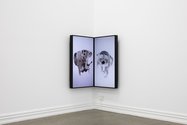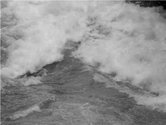John Hurrell – 26 April, 2016
The end result with these twirling ‘virtual' sculptures is not so much about technique or cinematic methodology but the act of looking. The familiar becomes strange so that items that are not especially rare become objects of meditation that are unexpectedly peculiar. Unusual angles and vistas occur where looking a chunk of mineral of eroded bone become pleasurable. You become aware of a form, the light on it, its angle to the light, its changing angle to the camera, and the speed of rotation.
Four slowly spinning images of weathered sheep skulls and a piece of turning jagged obsidian - and one other of gradually converging, descending waves - made up this installation of videos by Clinton Watkins downstairs at Starkwhite, set up in different screening formats.
Apparently with Watkins, the film production process involves no slow motion or post-production tinkering, but using a filming technique where the revolving object appears to hover in deep space. Somehow Watkins has designed a non-digital method where the camera turns in a looping path around the natural object, while any supporting structures holding it up are kept hidden.
The end result with these twirling ‘virtual’ sculptures is not so much about technique or cinematic methodology but the act of looking. The familiar becomes strange so that items that are not especially rare become objects of meditation that are unexpectedly peculiar. Unusual angles and vistas occur where looking a chunk of mineral of eroded bone become pleasurable; ‘normal’ or ‘correct’ positions become obsolete - a process similar to that of analytic cubism where orthodox vistas are avoided. You become aware of a form, the light on it, its angle to the light, its changing angle to the camera, and the speed of rotation.
One work showing foaming waves at the base of Huka falls, filmed from high up, is screened on an obsolete monitor positioned on an old pottery tripod so that the film is part of an object with a flat horizontal board. The two axes (vertical and horizontal) meet at the screen, intersecting with a strange wit.
Another with a dark obsidian crystal, set against a black background, concentrates on the properties of raking light - for the mineral form is hard to revel in, its distant parts disappearing into the void. The screen is vertical and leans against the wall at an angle so that it is emphasised as an object - an oblong slab - even though it is peered through.
The main presences in the show are the revolving ewe skulls: one vertical, double-screened and set in a corner, the other single and horizontal. The double-screened skull is more battered and damaged than the other, while Watkins’ choice of subject matter is drolly amusing: our national icon, a possible comment on our meat and wool industry (its traditional GNP importance) and the fact that many gallery visitors won’t know what type of skull it is. It seems to set out a rural (sheep) / urban (contemporary art) distinction: a division of knowledge.
It is quite a while since Watkins last exhibited in Starkwhite, and this audio/visual show (which has a hard-to-locate hum) is not nearly as immersive or as holistic as on previous occasions. It is though, typical, with its videos exploiting repetition, but also new as a form of revolving ‘sculpture’.
John Hurrell

















 Two Rooms presents a program of residencies and projects
Two Rooms presents a program of residencies and projects Advertising in this column
Advertising in this column



This Discussion has 0 comments.
Comment
Participate
Register to Participate.
Sign in
Sign in to an existing account.